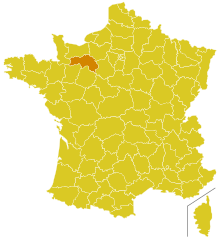Roman Catholic Diocese of Séez
Catholic diocese in France From Wikipedia, the free encyclopedia
Catholic diocese in France From Wikipedia, the free encyclopedia
The Diocese of Séez (Latin: Dioecesis Sagiensis; French: Diocèse de Séez) is a Latin Church diocese of the Catholic Church in France. Originally established in the 3rd century, the diocese encompasses the department of Orne in the region of Normandy. The episcopal see is the cathedral in Sées,[1] and the diocese is a suffragan of the Archdiocese of Rouen.
This article needs additional citations for verification. (July 2016) |
Diocese of Séez Dioecesis Sagiensis Diocèse de Séez | |
|---|---|
 | |
| Location | |
| Country | |
| Ecclesiastical province | Rouen |
| Metropolitan | Archdiocese of Rouen |
| Statistics | |
| Area | 6,103 km2 (2,356 sq mi) |
| Population - Total - Catholics | (as of 2022) 279,942 261,000 (93.2%) |
| Information | |
| Denomination | Catholic |
| Sui iuris church | Latin Church |
| Rite | Roman Rite |
| Established | 3rd Century |
| Cathedral | Cathedral Basilica of Notre Dame in Sées |
| Secular priests | 58 (Diocesan) 34 (Religious Orders) 25 Permanent Deacons |
| Current leadership | |
| Pope | Francis |
| Bishop elect | Bruno Feillet |
| Metropolitan Archbishop | Dominique Lebrun |
| Map | |
 | |
| Website | |
| orne.catholique.fr | |
In 2022, in the Diocese of Séez there was one priest for every 2,836 Catholics.
Saint Ebrulf, a native of the Diocese of Bayeux, founded, after 560, several monasteries in the Diocese of Séez; one of them became the important Abbey of Saint-Martin-de-Séez, which, owing to the influence of Richelieu, its administrator-general, was reformed in 1636 by the Benedictines of Saint-Maur. Rotrou II, Count of Perche, in fulfillment of a vow, established in 1122, at Soligny, the Abbey of La Trappe, in favour of which bulls were issued by popes Eugene III (1147), Alexander III (1173) and Innocent III (1203), and which was reformed in 1662 by Abbot Armand Jean le Bouthillier de Rancé.
During the French Revolution the Trappists went with Dom Augustin de Lestranges, 26 April 1791, into Switzerland, where they founded the convent of La Val Saint, but returned to Soligny soon after the accession of Louis XVII. Among the abbots of the Trappist monastery at Soligny were: Cardinal Jean du Bellay, who held a number of bishoprics and resigned his abbatial dignity in 1538; the historian Dom Gervaise, superior of the abbey from 1696–8.
On the occasion of the St Bartholomew's Day massacre in 1572 Matignon, leader of the Catholics, succeeded in saving the lives of the Protestants at Alençon. The cathedral of Séez dates from the twelfth century; that of Alençon was begun in the fourteenth.
The diocese was re-established by the Concordat of 1802, which, by adding to it some parishes of the Dioceses of Bayeux, Lisieux, Le Mans and Chartres, and by cutting off some districts formerly included in it, made it exactly coextensive with the department. It is suffragan to the Archdiocese of Rouen in Normandy.
In 1884 Monseigneur Buguet, curé of Montligeon chapel, founded an expiatory society for the abandoned souls in Purgatory, since erected by Pope Leo XIII into a Prima Primaria archconfraternity, which publishes six bulletins in different languages and has members in every part of the world. Notre Dame de la Chapelle Montligeon is also a place of pilgrimage. The Grande Trappe of Soligny still exists in the Diocese of Séez, which before the application of the law of 1901 against religious congregations had different teaching congregations of brothers, in addition to the Redemptorists. Among the congregations of nuns originating in the diocese may be mentioned: the Sisters of Providence, a teaching and nursing institute founded in 1683 with mother-house at Séez; the Sisters of Christian Education, established in 1817 by Abbé Lafosse, mother-house at Argentan, and a branch of the order at Farnborough in England; the Sisters of Mercy, founded in 1818 by Abbé Bazin to nurse the sick in their own homes.
According to the Georges Goyau,[2] "Louis Duchesne believed that for the period anterior to 900 no reliance can be placed on the episcopal catalogue of Séez, which we know by certain compilations of the sixth century." A later tradition assigns Saint Latuinus to the first century and makes him a missionary sent by Pope Clement I.
Some saints were especially venerated in this diocese. These included Ravennus and Rasyphus, martyred in the diocese about the beginning of the third century. Saint Céronne (d. about 490) founded two monasteries of nuns near Mortagne; and Saint Cenerius, or Céneri (d. about 669), born at Spoleto, was the founder of the monastery of Saint Cenerius. Saint Opportuna, sister of Saint Chrodegang,[4] and her aunt, Saint Lanthilda, were abbesses of the two monasteries of Almenèches (end of the seventh or beginning of the eighth century). Saint Evremond (d. about 720) was the founder of the monasteries of Fontenay les Louvets and Montmevrey. Saint Osmund, Bishop of Salisbury (d. 1099), as Comte de Séez, followed William the Conqueror into England.
The chief pilgrimages in the diocese were Notre-Dame de Champs at Séez, Notre-Dame du Vallet, Notre-Dame du Repos, near Almenèches, three very ancient shrines; Notre-Dame de Lignerolles, a pilgrimage of the seventh century; Notre-Dame de Recouvrance, at Les Tourailles, dating beyond 900; Notre-Dame de Longny, established in the sixteenth century; Notre-Dame du Lignon, a pilgrimage of the seventeenth century.

Seamless Wikipedia browsing. On steroids.
Every time you click a link to Wikipedia, Wiktionary or Wikiquote in your browser's search results, it will show the modern Wikiwand interface.
Wikiwand extension is a five stars, simple, with minimum permission required to keep your browsing private, safe and transparent.